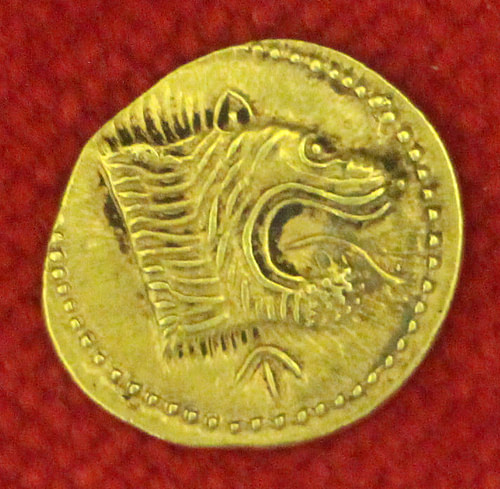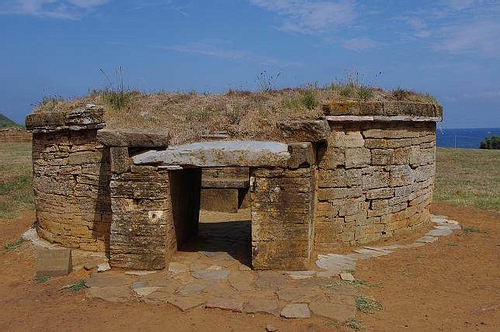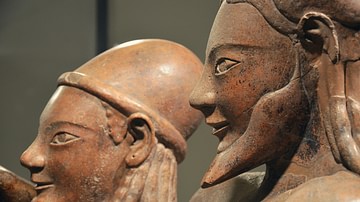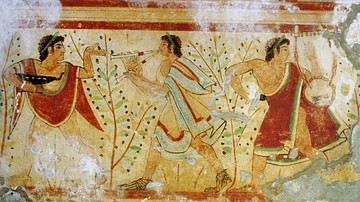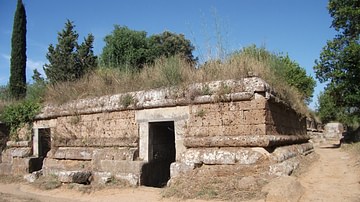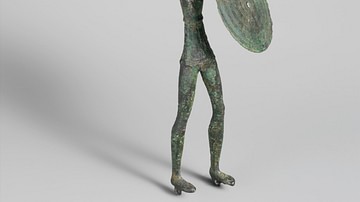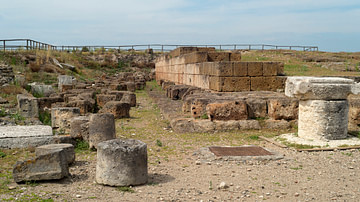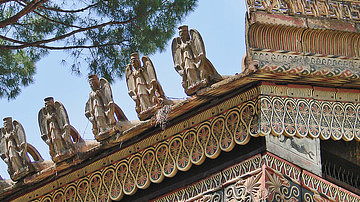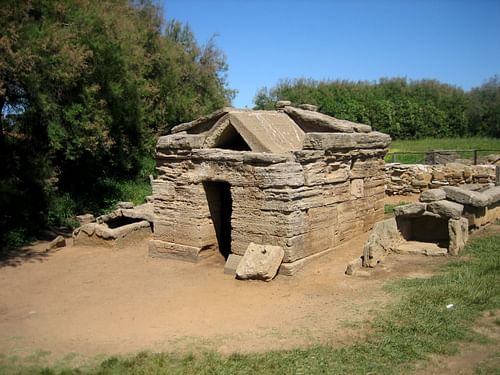
Populonia (Etruscan name: Pupluna or Fufluna), located on the western coast of Italy, was an important Etruscan town which flourished between the 7th and 2nd century BCE. Rich in metal deposits and so noted for its production of pig iron, it has become known as the 'Pittsburgh of antiquity;' the town was a successful trading port, able to mint its own coinage. 7th and 5th century BCE tombs survive at the site, including large tumuli and square stone aediculae set in rows.
Early Settlement
The earliest archaeological evidence of settlement are the cemeteries belonging to the Villanovan culture (1000-750 BCE), a precursor of the Etruscans. The settlement of Populonia benefitted from its location on the coast where it could act as a trading centre between incoming goods shipped by sea from the wider Mediterranean and export the minerals mined from the interior of Etruria. There were also long-standing trade relations with Sardinia. With its own port in the only Etrurian natural harbour (the Gulf of Baratti), Populonia was the only Etruscan town to be constructed directly on the coast. The Etruscan name for the town - Fufluna - is derived from the Etruscan god of wine Fufluns, and this may indicate viticulture was an early source of wealth. More certain is that Populonia became prosperous based on its production of bronze, using copper and tin deposits found in the nearby hills.
Even more important than all its other resources put together, Populonia was particularly noted as a smelting centre for iron coming from Elba. The island had exhausted its supply of wood needed for charcoal used in the smelting process and so was forced to send iron ore across to the mainland for treatment. It is interesting to note that archaeology has shown that the Populonians did not make the same mistake of mass deforestation. Analysis of charcoal remains at the town show that it typically came from trees which were 20 years old, suggesting there was some forest management and trees were cut on a rotation basis. Iron would bring great wealth to Populonia's ruling class, and as historian J. Heurgon points out, it would make the city as famous in antiquity as Pittsburgh was in the 20th century CE for its steel.
A THRIVING ETRUSCAN CITY
Populonia's prosperity is evidenced in the tumuli, rock-cut and stone block tombs, at the site and in the production of its own coinage, surviving examples of which from the early 5th century BCE show a lion's head. These coins were minted from gold and stamped with value marks of 25 or 50, probably in relation to their weight as in contemporary East Greek city-states. Examples of bronze coins carry a head of Minerva with the inscription Pupluna while silver coins have a design showing a Gorgon's head. One such silver coin has been found as far north as Lake Como, indicating the reach of Populonia's trade network. Pottery fragments have been found across the site, and those with name inscriptions indicate that their owners could be slaves and foreigners, another measure of Populonia's successful links with the wider Mediterranean.
Populonia was on of the 12 (or perhaps 15) Etruscan towns which formed the loose confederacy known as the Etruscan League. Very little is known of this league except that its members had common religious ties and that leaders met annually at the Fanum Voltumnae sanctuary near Orvieto (exact location as yet unknown). The other members of the league included Cerveteri (Cisra), Chiusi (Clevsin), Tarquinia (Tarchna), Vulci (Velch), and Veii (Vei). As in other Etruscan cities, Populonia's first form of government was a monarchy which was then replaced by a ruling oligarchy of the town's aristocracy.
Located some way to the north of other Etrurian settlements, Populonia seems to have avoided the mid-5th to mid-4th century BCE crisis that hit most southern Etruscan towns following the rise of Syracuse. The Sicilian city took over the local sea trade and attacked the Etrurian coast further south during the reign of Dionysius I (405-367 BCE). The end of Etruscan Populonia came when Rome conquered the region in the 2nd century BCE and Populonia was assimilated both politically and culturally, along with its still important iron production facilities, into the growing empire of the Republic.
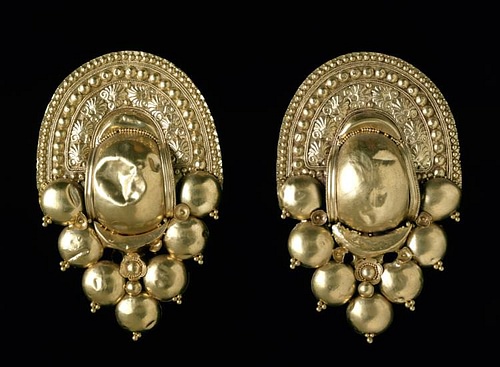
Archaeological Remains
Archaeological remains at Populonia include tombs from the 7th century BCE onwards, foundations of 5th-century BCE sacred and private buildings as well as metal workshops including a foundry with smelting furnaces, iron slag, and quarters for metal workers. In addition, there are substantial portions of the city's fortification walls – built in the 6th century BCE around the acropolis and 4th-3rd century BCE for the portions linking the town to the port.
Tombs at Populonia include tumuli – structures with low chambers made of stone set on sloping stone pavings to aid drainage, a roof of stone slabs, and all covered with an earth and grass mound. Some examples have a short corridor entrance and stelae set on each side of the doorway. These tumuli tombs date to the 7th century BCE and were in use for several generations.
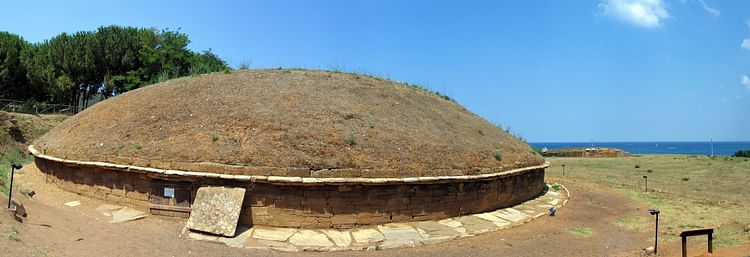
Tomb of the Chariots
One of the biggest tumuli tombs is the 28 metres across Tomb of the Chariots (Tombe dei Carri). Dating from the mid-7th to early 6th century BCE, it contained the remains of four individuals. Like most of the tombs at Populonia, it was looted in antiquity, but excavations have revealed two gold pendants and a fibula from the main chamber. The small side chambers were, fortunately, intact and contained two horns (one of silver gilded ivory and another of bronze), a knife with ivory handle, iron weapons, horse bits, a chariot, and a two-wheeled carriage. The vehicles were made of iron, bronze, leather, and oak wood, the latter now perished. The bronze panels which once decorated the three sides of the chariot were inlaid with hunters and animals rendered in iron. The artwork on the finds indicates the influence of Cyprus and Phoenicia, a contact further attested by the presence of a Phoenician terracotta oil lamp in the tomb.
Tomb of the Bronze Fans
Another tomb of interest is the Tomb of the Bronze Fans (Tombe dei Flabelli di Bronzo) which was, remarkably, found intact. The entrance to the tumulus has a plain limestone stela standing on each side, probably originally painted. Within were four burials dating from 630 to 560 BCE. Gold jewellery pieces included a fibula, hair spirals, earrings, and a ring. Alabaster perfume bottles with tops carved into the bust of a woman, an ivory comb, weapons, bronze armour and shield, incense burners, food utensils and cooking paraphernalia, and pottery – both locally made bucchero and examples from Corinth and Rhodes. Giving the tomb its name were three fans made from thin sheets of embossed bronze. Fans were status symbols for both males and females of the Etruscan elite, and the most striking of the examples found here is almost a full circle with only a portion cut away to make room for the handle which is of wood covered in thin bronze. The central disk has two women facing each other with each wearing a long check-pattern cloak.
Tomb of the Bronze Statuette of the Offering Bearer
Most 5th-century BCE tombs at the site are shallow rock-cut graves known as casone tombs. They are laid out along two roads in a straight line at the Casone necropolis. Wealthier families, meanwhile, buried their dead in more impressive but still small square buildings of stone blocks. These have gabled roofs made from stone slabs and are known as an aedicula. They were once decorated with painted stone or terracotta acroteria. A single doorway entrance leads to a single chamber, which was used for multiple internments over time. The finest, perhaps, is the 'Tomb of the Bronze Statuette of the Offering Bearer' (Tomba del Bronzetto di Offerente), so called after the discovery of a figurine of a man making a votive offering inside. The structure is also located in the Casone necropolis and dates to c. 530-500 BCE or perhaps a little later. It was used for interments for over a century.
Objects buried with the dead from these later tombs include bronze utensils, candelabras, and jewellery pieces. Amongst the more impressive finds are examples of fine Greek pottery, especially from Attica. Two fine hydrai (for water) by the Meidias Painter, which are now in the Archaeological Museum of Florence, and a kylix (drinking cup), which is helpfully inscribed with the complete Etruscan alphabet. The kylix is signed by a Greek whose name has been Etruscanised from Metron to Metru, another indicator not only of the Greek cultural influence on Etruria but also of Populonia's wider reach in the ancient Mediterranean.
